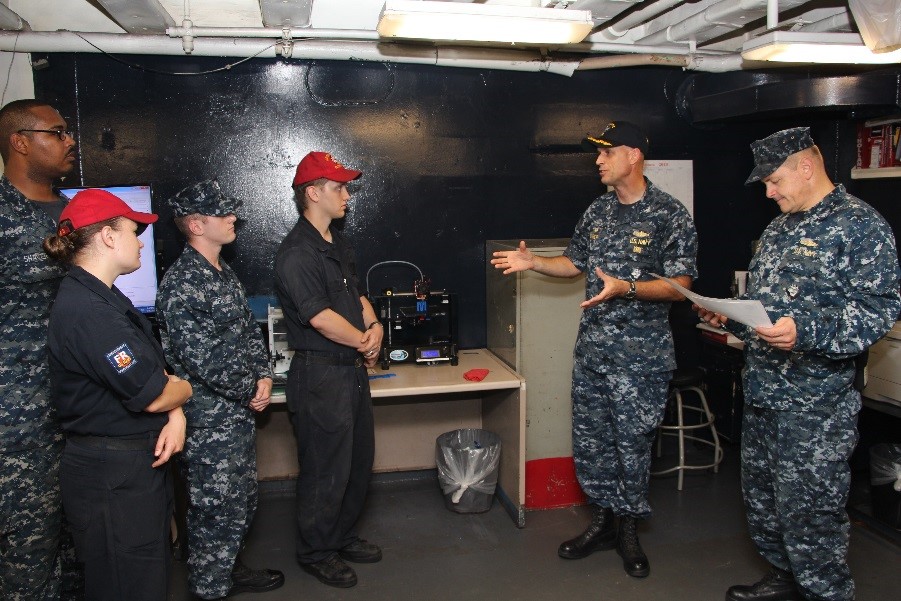
Broadening access to the tools, technologies, and spaces that enable individuals to develop innovative solutions to challenges is at the heart of the maker movement. This is especially true for members of the U.S. armed forces: for instance, the Army’s Rapid Equipping Force has deployed 3D printers and other rapid fabrication technologies to the front lines, and earlier this year, the Navy, in collaboration with the Defense Research Projects Agency (DARPA), launched the Fab Lab at the Mid-Atlantic Regional Maintenance Facility (MARMC) in Norfolk, VA. The Fab Lab is the first makerspace to be located on a Naval base.
In June 2014, the President launched the Nation of Makers initiative, an all-hands-on-deck call to give many more students, entrepreneurs, and citizens access to a new class of technologies—such as 3D printers, laser cutters, and desktop machine tools—that are enabling more Americans to design, build, and manufacture just about anything. Earlier this year, the President proclaimed a National Week of Making and the Administration announced important progress on the Nation of Makers initiative, including commitments from federal agencies, universities, companies and schools to advance and support problem-solving, innovation, education, and entrepreneurship.
Recently we spoke with Lieutenant Todd Coursey, the Fab Lab Project Officer at MARMC about how this new space will further enable innovation and the Navy’s involvement in the maker movement:

Tom and Stephanie: What is a Fab Lab?
Todd: At the Navy’s Mid-Atlantic Regional Maintenance Facility, where I am stationed, our Fab Lab provides advanced digital-fabrication training and tools so that Navy personnel can develop innovations to help with ship maintenance and overall operations. The Fab Lab has a set of rapid prototyping equipment, which includes a laser cutter, a 3D printer, a vinyl cutter, an electronics workbench, a computer controlled numerically controlled (CNC) mill, and hand tools.
What made you decide to launch the Navy's first Fab Lab?
I saw the opportunity to invest in the ideas of the deck-plate sailor and operator, the thousands of disruptive thinkers who inhabit ships and the waterfront. These new digital-manufacturing capabilities are now easier to use than ever before and can create a strategic advantage for our nation if we choose to employ them.
The Fab Lab is supported by the Defense Advanced Research Projects Agency (DARPA), as a part of the MENTOR2 (manufacturing, experimentation, and outreach) program, which seeks to enhance readiness by improving the training and tools available to warfighters and those serving on the front lines.
How are Navy sailors currently using the Fab Lab?
Sailors are learning about electronics design, producing circuit boards using a variety of sensors and programming microcontrollers. They’ve produced a variety of special tools and parts, such as a custom tool to support maintenance of more than 500 fleet gas turbines to prototyping a hard-drive case that enables us to repair individual components instead of replacing an entire unit. Honestly, my favorite product is a hat rack we made in the lab: Sailors became tired of hanging their clothes on any horizontal surface they could find, so they used recycled wood on the CNC mill to make a base, then designed and 3D printed some hanging hooks.

What are the Navy's next steps in embracing Fab Labs and the maker movement?
In the coming year, the Secretary of the Navy’s Task Force Innovation effort will be establishing mobile Fab Labs based at several other critical Fleet locations in San Diego (CA), Mayport (FL) and Cherry Point (NC).
Another large step is continuing to network and expand the Navy’s existing innovation-centered programs and commands, such as the HATCH, Navy’s crowdsourcing and collaboration environment, and Project Athena, which involves “shark tank”-style innovation pitches to officers.
In the coming months, the Navy will launch the first-ever Fleet Design Challenge, to encourage the global Navy community to develop creative solutions to simple, real-world problems faced by their peers.
In addition to our initial, fixed-base Fab Lab in Norfolk, VA, we have successfully deployed two “afloat mini-labs” on ships. These spaces will continue to expand Navy’s capacity for ongoing, in-situ innovation.
Tom Kalil is Deputy Director for Technology and Innovation at the White House Office of Science and Technology Policy.
Stephanie Santoso is Senior Advisor for Making at the White House Office of Science and Technology Policy.

